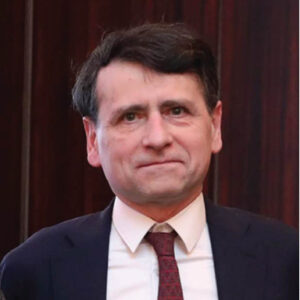In view of the looming HFC phase-down and phase-out deadlines set by the Kigali Amendment to the Montreal Protocol, GCC region countries are being urged to move away from traditional cooling solutions. To this end, stakeholders during the 4th edition of Refrigerants Review, presented as part of CPI Industry’s HVACR Virtual Conference Series, discussed the opportunities District Cooling holds in view of increasingly stringent regulations. Hannah Jo Uy has the story…

Yaqoub Almatouq
Although much of the global community remains largely in a state of flux, owing to the upheaval caused by COVID-19, Yaqoub Almatouq, Kuwait National Ozone Officer, emphasised that countries must not take their foot off the pedal when it comes to lowering global emissions. “We have safety issues as humans, but that cannot stop us from doing our job and giving our best,” Almatouq, who is also Head, Ozone Section, Environmental Public Authority, Kuwait, said. “In Montreal Protocol, we spent almost 33 years dealing with the environmental issues and the effects of these refrigerants and technologies, finding answers, pathways and solutions, whenever we could.”
Almatouq, who served as Chair of the event, said, the issue of refrigerants is even more critical for countries in the Middle East, owing to the region’s heavy dependence on cooling, which is a necessity rather than a luxury for most countries in the region. “When we talk about refrigerants, we talk about air conditioning, food preservation, vaccine and medicine,” he said. “Even transportation is connected to cooling systems and refrigerants, so when we talk about refrigerants, we talk about our standard of living.” As such, Almatouq pointed out, the GCC region should pursue a more proactive and collaborative approach to better understand and solve challenges on the road to lowering HFCs.
Almatouq highlighted the importance of the key topics of discussion allocated for the webinar, which touched on how the Middle East region can leapfrog to better cooling technologies, in view of the phase down; safety concerns and flammability of certain refrigerants; and the safety measures and parameters equipment manufacturers using these refrigerants should take into consideration.
Regulatory trends
For Almatouq, a discussion surrounding refrigerants would be incomplete without first touching on regulation surrounding the performance of alternative refrigerants and associated technologies. “Whenever anyone wants to have an AC or looks at how to design air conditioning in a facility, we have one thing to do,” he said. “From the very beginning, we talk about the regulation, the energy efficiency and the refrigerant we can use. If countries don’t have rules and regulation, then we have a big problem for the industry to adopt and achieve things that need to be done.”

Didier Coulomb
Didier Coulomb, Director General, International Institute of Refrigeration, agreeing with this, pointed out that undoubtedly, there would be more, and stricter regulations and standards surrounding energy consumption, refrigerants as well as all supporting and relevant technologies. When it comes to air conditioning equipment, Coulomb said, there is a significant gap between the most and the least energy-efficient equipment. “In any case, it is possible to really improve the energy efficiency of the equipment and for labeling the good equipment,” he said. “There will also be more standards regarding whole systems and standards on buildings.” There are already examples of systems being implemented, with a number of supermarkets presenting important profiles. “We are currently working with UNIDO to publish a guide on what are important to reduce the energy consumption and use low-GWP refrigerants, especially CO2 and ammonia,” he said.
Regarding refrigerants, Coulomb said that while the Kigali Amendment remains firmly in place, many countries in the world, such as in Europe, are already having discussions on initiating stricter phase-down or phase-out of some applications of high-GWP refrigerants. “In the long term, there will be almost phase-out of high-GWP refrigerants, and of course, there will also be regulations regarding safety, because most of the technologies we can use to reduce the refrigerant impact, which is one-third of the impact of the equipment, are using flammable refrigerant – whether mild or highly flammable,” he said. “Internationally, there are new standards for hydrocarbon. There will be a place for this refrigerant, even if it’s not used a lot.”
Additionally, Coloumb said, it is likely that in the future, taxes will be used as incentive to promote adoption of better refrigerants. “We already have some taxes on some refrigerants,” he said. “In some countries, there would be taxes and higher prices, but it would be a driver for reduction of technology for the rest of the world. Perhaps, it’s not good news, more regulations and constraints. It is more challenging, but it is necessary for engineers to be more involved; in order to propose better design of equipment, you have to think about the whole system.”
Design considerations

Dr Moataz T Bakheet
With regulations and standards in place, it is now up to developers and designers to deliver the most optimum projects, with stakeholders agreeing there should be a culture of innovation to not only meet existing standards but also to move beyond it. In line with this, Dr Moataz T Bakheet, Director, Madinah Office & Western Region Projects, Zuhair Fayez Partnership, Saudi Arabia, shared his experience with a development in Madinah, which was particularly challenging, being a high-density project in a small area surrounding the Prophet’s Mosque. “The unique nature of the project has given way to unique consideration at the beginning of the development, more than two years ago, which included concerns related to the air conditioning and refrigerant transition,” he said. Dr Bakheet said there were three main concerns surrounding the project, the first being availability of power, as there were only two power transmission plants. “If we go with traditional systems, we would need approximately four plants,” he said. Another concern was related to the high-density area. “We have 400 hotel towers that accommodate 300,000 people,” he said. “You can imagine how much capacity is needed to have this amount of population in a small area. In high-rise buildings that have 12-16 floors, you need to take into consideration safety and efficiency.” The third concern, Dr Bakheet said, was related to the architecture of the area. “If you go with conventional system, you will face a kind of visual pollution,” he said. “Formation is very important to us to have a good community surrounding the Prophet’s Mosque.”
To address the concerns, Dr Bakheet said, the team working on the project had to customise regulation in the central area, taking into account international codes for buildings, electricity and fire safety and also taking into account considerations and guidelines from ASHRAE and NFPA, among other relevant bodies. “It [customised regulation) is a way for them to force investors and stakeholders to go for unconventional systems and centralised systems for greater efficiency,” he said. “And with the Montreal Protocol, at the end of the 1980s, it was good for us to put restrictions to fulfill requirements of the Protocol. It gave us a chance to come up with unconventional systems, like VRF, centralised chilled water system, avoiding conventional DX, split and window type, which is also not good for concerns I mentioned in the beginning.”
Dr Bakheet added that following a study, the team found that district cooling is the most optimum solution for the area, in terms of offering the highest efficiency. Although there were challenges, he said, such as obtaining permission to excavate roads and developing the infrastructure, they still believe in the benefits of district cooling, in view of its contribution to the urban fabric, by way of appealing architectural facades and high efficiency. “We tried, and I believe this experience gave us a chance for future development to follow business standards and go with district cooling in new developments, coming in the next five years,” he said.
Is district cooling a key to meeting phase-down requirements?

Ibrahim Hesham Hassanien
Agreeing with Dr Bakheet, Almatouq highlighted the need for the industry to go beyond conventional systems and to start choosing a wider scope of technologies. Ibrahim Hesham Hassanien, Projects Engineer, Allied Consultants, UAE, also agreed with Dr Bakheet. Hassanien discussed the types of refrigerant and concerns over safety and the environment, in relation to the district cooling sector in the GCC region. He said that there have been huge developments in the GCC region countries. He added that governments, authorities and organisations should be aware that a key benefit through choosing district cooling is that refrigerants are confined to central plants rather than scattered in individual units. This, he said, reduces environmental risk, especially if chillers are designed in accordance with codes and ASHRAE guidelines. “The amount of refrigerant in a DCP is less than if you consider standalone units,” he said. “If we have a development of one million square metres, with 25,000 refrigerated tonnes, this would be almost 20,000 kg of refrigerant inside the DCP. If you go with standalone, you can go up to 34 kg for individual units, owing to the technology and diversity factors.”
Hassanien said that defining refrigerants with low GWP and ODP is essential in designing district cooling plants. “The two major refrigerants utilised in DCPs by chiller manufacturers are R-134a and R-1233zd,” he said. “If we take a close look to compare between them, R-134a is an HFC with GWP of 1,300, ODP of zero and an atmospheric life of almost 14 years, in comparison to R-1233ZD, which is an HFO with a GWP of 1 and an ODP of almost zero, and almost zero atmospheric life.” He added that an incentive in specifying R-1233zd is the negative pressure. “It’s a negative pressure gas, so leakage from the equipment will not be likely,” he said. “This is why it’s mostly recommended; unfortunately, due to economic reasons, some manufacturers are still working with R-134a, but we are now looking at the R&D towards including the new refrigerants, R-1233ZD or similar, because machines that are able to accommodate R-134a would no longer be available from January 2024.”
Hassanien said that having refrigerant recovery units in the district cooling plant is also an important design consideration for the team. “This is so the maintenance required for the chiller or refrigerant leakage is reduced through the refrigerant detectors,” he said. “The refrigerant can be stored in the unit until required maintenance or repair is completed. The design of the refrigerant recovery unit is usually based on at least one chiller capacity, out of the DCP size.”
Hassanien added that another important consideration from the perspective of DCP and while combining the refrigerant of the whole development in one or several plants, is the high safety measures in design of DCP for emergency cases, including refrigerant relief piping for the outside of the building itself. The refrigerant exhaust fans, he said, helps in ensuring the make-up fresh air for the people working inside is maintained. “Overall, we encourage that in future developments, the authorities and government take more actions in utilising DCP,” he said.
For Almatouq, district cooling is a “must and a need” in this part of the world and that it could help the GCC region meet the global refrigerant phase-down and phase-out requirements.
#HVAC #HVACR #airconditioning #buildingperformance #airconditioningmiddleeast #airconditioningdubai #HVACDubai #HVACRDubai #HVACUAE #HVACRUAE #districtcooling #districtcoolingDubai #districtcoolingUAE #districtcoolingGCC #DeltaT #energyefficiency #MEP #refrigerants #HFC #phasedown #HFCphasedown #phaseout #HFCphaseout #MontrealProtocol #KigaliAgreement #retrofit #buildingretrofit #renovation #buildingrenovation #MEPcontracting #contracting #MEPcontractor #MEPcontractors #innovation #HVACinnovation #HVACinnovations #AlShirawai #digital #digitalHVAC #COVID-19 #COVID #DCP #R134a #R-134a #R1233zd #R-1233zd #HFO #HFOs #ozone #ozonedepletingsubstances #ODS #ODP #environment #climate #climatechange #climatecrisis #climatechangemitigation #foodpreservation #transportrefrigeration #flammability #flammablerefrigerants #refrigerantsafety #AC #IIR #energyefficiency #energy-efficient #UNIDO #carbon #ammonia #ammoniarefrigerant #ASHRAE #NFPA #splitairconditioners #splitACsystems #RAC #RACs #VRF #VRFs
Copyright © 2006-2025 - CPI Industry. All rights reserved.